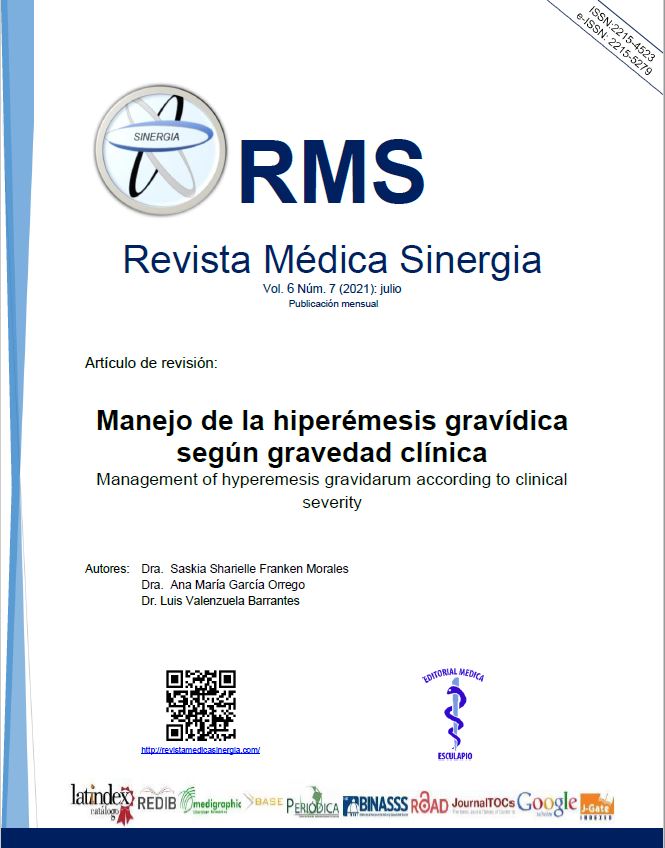Resumen
La mayoría de las embarazadas presentan náuseas y vómitos. Los síntomas suelen iniciar de 2 a 4 semanas posterior a la fertilización y por lo general resuelven a las 22 semanas de gestación. La hiperémesis gravídica se define como la ocurrencia de tres o más vómitos diarios, asociado a cetonuria y pérdida de peso mayor a 3 kilogramos o 5% del peso inicial. Aunque la hiperémesis gravídica presenta una baja mortalidad, sigue siendo una fuente importante de morbilidad por lo que impera un diagnóstico temprano.
Palabras clave
Citas
Bustos M, Venkataramanan R, Caritis S. Nausea and vomiting of pregnancy - What's new?. Autonomic Neuroscience: Basic and Clinical. 2017;202:63-65. Available from: http://dx.doi.org/10.1016/j.autneu.2016.05.002
Piñel Pérez C, Gómez-Roso Jareño M, García García A, López Galián J. Hiperemesis gravídica severa causada por Helicobacter pylori. Enfermedades Infecciosas y Microbiología Clínica. 2021;:1. Available from: https://doi.org/10.1016/j.eimc.2020.12.012
Nurmi M, Rautava P, Gissler M, Vahlberg T, Polo-Kantola P. Recurrence patterns of hyperemesis gravidarum. American Journal of Obstetrics & Gynecology. 2018;219(5):469.e1-469.e3. Available from: https://doi.org/10.1016/j.ajog.2018.08.018
London V, Grube S, Sherer D, Abulafia O. Hyperemesis Gravidarum: A Review of Recent Literature. Pharmacology. 2017;100(3-4):162-164. Available from: https://doi.org/10.1159/000477853
Kames Kjeldgaard H, Eberhard-Gran M, Šaltytė Benth J, Nordeng H, Vigdis Vikanes Å. History of depression and risk of hyperemesis gravidarum: a population-based cohort study. Archives of Women's Mental Health. 2017;20(3):397-404. Available from: https://doi.org/10.1007/s00737-016-0713-6
S. Fejzo M, Trovik J, J. Grooten I, Sridharan K, J. Roseboom T, Vikanes Å et al. Nausea and vomiting of pregnancy and hyperemesis gravidarum. Nature Reviews Disease Primers volume. 2019;62(5):3-9. Available from: https://doi.org/10.1038/s41572-019-0110-3
Wakefield MacGibbon K. Hyperemesis Gravidarum: Strategies to Improve Outcomes. Journal of infusion nursing. 2020;43(2):82-84. Available from: https://doi.org/:10.1097/NAN.0000000000000363
Austin K, Wilson K, Saha S. Hyperemesis Gravidarum. Nutrition in Clinical Practice. 2019;34(2):229-231. Available from: https://doi.org/10.1002/ncp.10205
Agmon N, Sade S, Pariente G, Rotem R, Y. Weintraub A. Hyperemesis gravidarum and adverse pregnancy outcomes. Archives of Gynecology and Obstetrics. 2019;300:348-353. Available from: https://doi.org/10.1007/s00404-019-05192-y
C. Boelig R, J. Barton S, Saccone G, J. Kelly A, J. Edwards S, Berghella V. Interventions for treating hyperemesis gravidarum: a Cochrane systematic review and meta-analysis. The Journal of Maternal-Fetal & Neonatal Medicine. 2018;31(18):2496-2499. Available from: https://doi.org/10.1080/14767058.2017.1342805
Abramowitz A, S. Miller E, L. Wisner K. Treatment options for hyperemesis gravidarum. Archives of Women's Mental Health. 2017;20(3):5-6. Available from: https://doi.org/10.1007/s00737-016-0707-4
Koren G, Ornoy A, Berkovitchace M. Hyperemesis gravidarum—Is it a cause of abnormal fetal brain development?. Reproductive Toxicology. 2018;79:84-85. Available from: https://doi.org/10.1016/j.reprotox.2018.06.008
Varela P, Deltsidou A. Hyperemesis gravidarum and neonatal outcomes: A systematic review of observational studies. Taiwanese Journal of Obstetrics & Gynecology. 2021;60(3):422-424. Available from: https://doi.org/10.1016/j.tjog.2021.03.007
Cotaina G, Lazaro G, Roca A, Lahoz P, Rodríguez L, Campillos-Maza J. Encefalopatía de Wernicke en gestante con hiperemesis gravídica grave. Ginecol Obstet Mex. 2017;85(2):93,94,97.
Maslin K, Shaw V, Brown A, Dean C, Shawe J. What is known about the nutritional intake of women with Hyperemesis Gravidarum?: A scoping review. European Journal of Obstetrics & Gynecology and Reproductive Biology. 2021;257:77-79. Available from: https://doi.org/10.1016/j.ejogrb.2020.12.003
Getahun D, Fassett MJ, Jacobsen SJ, Xiang AH, Takhar HS, Wing DA, Peltier MR. Autism Spectrum Disorders in Children Exposed in Utero to Hyperemesis Gravidarum. American Journal of Perinatology. 2019;38(3):266-270. Available from: https://doi.org/10.1055/s-0039-1696670
Žigrai M, Smetanová V, Gmitterová K, Klepancova P, Vyskočil M. Wernicke encephalopathy—a rare complication of hyperemesis gravidarum. European Journal of Clinical Nutrition. 2020;74:664-665. Available from: https://doi.org/10.1038/s41430-020-0592-9

Esta obra está bajo una licencia internacional Creative Commons Atribución-NoComercial 4.0.
Derechos de autor 2021 Array


